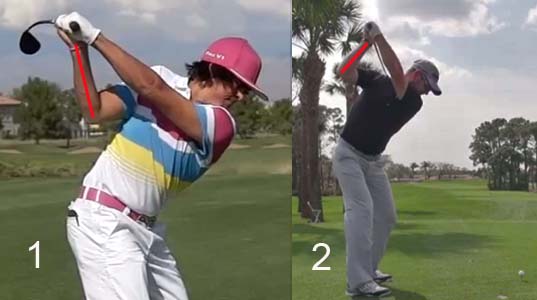
Relationship of the RFFW relative to the LAFW at the end-backswing position
Click here to go back to
the video project's index page.
At the end-backswing position, the right forearm flying wedge (RFFW) must support the left arm flying wedge (LAFW) - like the wingstrut of a Cessna airplane supports the wing of the airplane.

Jim George is at his end-backswing position with his left arm angled across his
shoulder turn angle.
Note that he has an intact LAFW (left arm is straight-line-aligned with his clubshaft) - represented by the two red lines that meet at the level of his left hand.
Note that his RFFW (which consists of the right forearm and the bent right wrist), and which is represented by the two blue lines, supports the LAFW (which is lying on his selected end-backswing swingplane) like a wingstrut supports the wing of a small Cessna airplane.
Note that the right forearm is approximately at a ~70 degree angle relative to plane of the intact LAFW and not at a 90 degree angle. Some TGM literalists believe that it should always be at a 90 degree angle, but that will only happen if a golfer has a very flexible right wrist that can easily dorsiflex back so that there is a 90 degree angle between the right forearm and the back of the right hand. Jim George finds it more biomechanically comfortable to have his right forearm at a ~70 degree angle relative to the plane of the intact LAFW (given his individual degree of right wrist flexibility), and that is perfectly acceptable from my personal perspective - because the RFFW is still adequately supporting the intact LAFW at his end-backswing position.
Note that his right forearm is angled roughly parallel to his spine, and that is biomechanically expected because his left arm is angled across his shoulder turn angle at his end-backswing position. His right forearm would be more vertical if his left arm was angled below his shoulder turn angle at his end-backswing position (as seen in Rickie Fowler's swing) and his right forearm would be more horizontal if his left arm was angled much steeper than his shoulder turn angle at his end-backswing position (as seen in Jim Furyk's swing or Rory Sabbatinni's swing or Steve Marino's swing).

Image 1 shows Rickie Fowler and image 2 shows Rory Sabbatinni at their respective
end-backswing positions.
I have drawn a red line down the length of their right forearm. Note that Rickie Fowler's right forearm is more vertically-oriented, while Rory Sabbatinni's right forearm is more horizontally-oriented.
Jeffrey Mann.
January 2017.